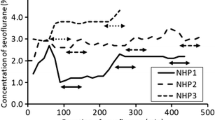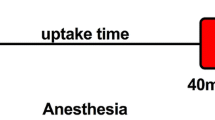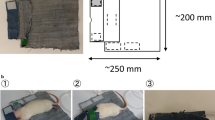Abstract
Purpose
PET (positron emission tomography) is a noninvasive imaging technique, visualizing biological aspects in vivo. In animal models, the result of PET study can be affected more prominently than in humans by the animal conditions or drug pretreatment. We assessed the effects of anesthesia, body temperature, and pretreatment with selective serotonin reuptake inhibitor on the results of [18F]N-3-fluoropropyl-2β-carbomethoxy-3β-(4-iodophenyl) nortropane ([18F]FP-CIT) PET in mice.
Methods
[18F]FP-CIT PET of C57BL/6 mice was performed in three different conditions: (1) anesthesia (isoflurane) with active warming (38°C) as a reference; (2) no anesthesia or warming; (3) anesthesia without warming at room temperature. Additional groups of mice pretreated with escalating doses of fluvoxamine (5, 20, 40, 80 mg/kg) were imaged in condition (1). The time activity curve and standardized uptake value of the striatum, cerebral cortex, and bone were compared among these conditions.
Results
In all conditions, radioactivities of the striatum and cortex tended to form a plateau after rapid uptake and washout, but that of bone tended to increase gradually. When anesthetized without any warming, all the mice developed hypothermia and showed reduced bone uptake with slightly increased striatal and cortical uptakes compared to the reference condition. In conditions without anesthesia, striatal and cortical uptakes were reduced, whereas the bone uptake showed no change. Pretreatment with fluvoxamine increased the striatal uptake and striatal specific to cortical non-specific uptake ratio, whereas the bone uptake was reduced.
Conclusion
Anesthesia, body temperature, and fluvoxamine affect the result of [18F]FP-CIT PET in mice by altering striatal and bone uptakes.





Similar content being viewed by others
References
Jones T. The imaging science of positron emission tomography. Eur J Nucl Med. 1996;23(7):807–13.
Jones T. The role of positron emission tomography within the spectrum of medical imaging. Eur J Nucl Med. 1996;23(2):207–11.
Chatziioannou AF. Molecular imaging of small animals with dedicated PET tomographs. Eur J Nucl Med Mol Imaging. 2002;29(1):98–114. doi:10.1007/s00259-001-0683-3.
Tornai MP, Jaszczak RJ, Turkington TG, Coleman RE. Small-animal PET: advent of a new era of PET research. J Nucl Med. 1999;40(7):1176–9.
Budinger TF, Benaron DA, Koretsky AP. Imaging transgenic animals. Annu Rev Biomed Eng. 1999;1:611–48. doi:10.1146/annurev.bioeng.1.1.611.
Cherry SR, Gambhir SS. Use of positron emission tomography in animal research. ILAR J. 2001;42(3):219–32.
Green MV, Seidel J, Vaquero JJ, Jagoda E, Lee I, Eckelman WC. High resolution PET, SPECT and projection imaging in small animals. Comput Med Imaging Graph. 2001;25(2):79–86.
Rao S, Verkman AS. Analysis of organ physiology in transgenic mice. Am J Physiol Cell Physiol. 2000;279(1):C1–C18.
Kleiber M. The fire of life: an introduction to animal energetics. Huntington, NY: R.E. Krieger; 1975.
Booij J, Tissingh G, Winogrodzka A, van Royen EA. Imaging of the dopaminergic neurotransmission system using single-photon emission tomography and positron emission tomography in patients with parkinsonism. Eur J Nucl Med. 1999;26(2):171–82.
Chaly T, Dhawan V, Kazumata K, Antonini A, Margouleff C, Dahl JR, et al. Radiosynthesis of [18F] N-3-fluoropropyl-2-beta-carbomethoxy-3-beta-(4-iodophenyl) nortropane and the first human study with positron emission tomography. Nucl Med Biol. 1996;23(8):999–1004.
Lundkvist C, Halldin C, Ginovart N, Swahn CG, Farde L. [18F] beta-CIT-FP is superior to [11C] beta-CIT-FP for quantitation of the dopamine transporter. Nucl Med Biol. 1997;24(7):621–7.
Pike VW. PET radiotracers: crossing the blood–brain barrier and surviving metabolism. Trends Pharmacol Sci. 2009;30(8):431–40. doi:10.1016/j.tips.2009.05.005.
Giron MC, Portolan S, Bin A, Mazzi U, Cutler CS. Cytochrome P450 and radiopharmaceutical metabolism. Q J Nucl Med Mol Imaging. 2008;52(3):254–66.
Tipre DN, Zoghbi SS, Liow JS, Green MV, Seidel J, Ichise M, et al. PET imaging of brain 5-HT1A receptors in rat in vivo with 18F-FCWAY and improvement by successful inhibition of radioligand defluorination with miconazole. J Nucl Med. 2006;47(2):345–53.
Ryu YH, Liow JS, Zoghbi S, Fujita M, Collins J, Tipre D, et al. Disulfiram inhibits defluorination of (18)F-FCWAY, reduces bone radioactivity, and enhances visualization of radioligand binding to serotonin 5-HT1A receptors in human brain. J Nucl Med. 2007;48(7):1154–61. doi:10.2967/jnumed.107.039933.
Matusch A, Meyer PT, Bier D, Holschbach MH, Woitalla D, Elmenhorst D, et al. Metabolism of the A1 adenosine receptor PET ligand [18 F]CPFPX by CYP1A2: implications for bolus/infusion PET studies. Nucl Med Biol. 2006;33(7):891–8. doi:10.1016/j.nucmedbio.2006.07.006.
Bier D, Holschbach MH, Wutz W, Olsson RA, Coenen HH. Metabolism of the A(1)1 adenosine receptor positron emission tomography ligand [18 F]8-cyclopentyl-3-(3-fluoropropyl)-1-propylxanthine ([18 F]CPFPX) in rodents and humans. Drug Metab Dispos. 2006;34(4):570–6. doi:10.1124/dmd.105.006411.
Jensen KG, Poulsen HE, Doehmer J, Loft S. Kinetics and inhibition by fluvoxamine of phenacetin O-deethylation in V79 cells expressing human CYP1A2. Pharmacol Toxicol. 1995;76(4):286–8.
Baumann P. Pharmacokinetic-pharmacodynamic relationship of the selective serotonin reuptake inhibitors. Clin Pharmacokinet. 1996;31(6):444–69.
DeVane CL, Gill HS. Clinical pharmacokinetics of fluvoxamine: applications to dosage regimen design. J Clin Psychiatry. 1997;58 Suppl 5:7–14.
Sihver W, Drewes B, Schulze A, Olsson RA, Coenen HH. Evaluation of novel tropane analogues in comparison with the binding characteristics of [18 F]FP-CIT and [131I]beta-CIT. Nucl Med Biol. 2007;34(2):211–9. doi:10.1016/j.nucmedbio.2006.11.005.
Lee SJ, Oh SJ, Chi DY, Kang SH, Kil HS, Kim JS, et al. One-step high-radiochemical-yield synthesis of [18 F]FP-CIT using a protic solvent system. Nucl Med Biol. 2007;34(4):345–51. doi:10.1016/j.nucmedbio.2007.02.007.
Kim JS, Lee JS, Im KC, Kim SJ, Kim SY, Lee DS, et al. Performance measurement of the microPET focus 120 scanner. J Nucl Med. 2007;48(9):1527–35. doi:10.2967/jnumed.107.040550.
Gordon CJ. Temperature regulation in laboratory rodents. Cambridge England ; New York, NY, USA: Cambridge University Press; 1993.
Eckenhoff RG, Fagan D. Inhalation anaesthetic competition at high-affinity cocaine binding sites in rat brain synaptosomes. Br J Anaesth. 1994;73(6):820–5.
Goodman MM, Kilts CD, Keil R, Shi B, Martarello L, Xing D, et al. 18 F-labeled FECNT: a selective radioligand for PET imaging of brain dopamine transporters. Nucl Med Biol. 2000;27(1):1–12.
Tsukada H, Nishiyama S, Kakiuchi T, Ohba H, Sato K, Harada N, et al. Isoflurane anesthesia enhances the inhibitory effects of cocaine and GBR12909 on dopamine transporter: PET studies in combination with microdialysis in the monkey brain. Brain Res. 1999;849(1–2):85–96.
Votaw J, Byas-Smith M, Hua J, Voll R, Martarello L, Levey AI, et al. Interaction of isoflurane with the dopamine transporter. Anesthesiology. 2003;98(2):404–11.
Kharasch ED, Thummel KE. Identification of cytochrome P450 2E1 as the predominant enzyme catalyzing human liver microsomal defluorination of sevoflurane, isoflurane, and methoxyflurane. Anesthesiology. 1993;79(4):795–807.
Welch MJ, Katzenellenbogen JA, Mathias CJ, Brodack JW, Carlson KE, Chi DY, et al. N-(3-[18 F]fluoropropyl)-spiperone: the preferred 18 F labeled spiperone analog for positron emission tomographic studies of the dopamine receptor. Int J Rad Appl Instrum B. 1988;15(1):83–97.
Bondy B, Spellmann I. Pharmacogenetics of antipsychotics: useful for the clinician? Curr Opin Psychiatry. 2007;20(2):126–30. doi:10.1097/YCO.0b013e328017f69f.
Kobayashi K, Yamamoto T, Chiba K, Tani M, Shimada N, Ishizaki T, et al. Human buprenorphine N-dealkylation is catalyzed by cytochrome P450 3A4. Drug Metab Dispos. 1998;26(8):818–21.
Tateishi T, Krivoruk Y, Ueng YF, Wood AJ, Guengerich FP, Wood M. Identification of human liver cytochrome P-450 3A4 as the enzyme responsible for fentanyl and sufentanil N-dealkylation. Anesth Analg. 1996;82(1):167–72.
Acknowledgement
This study was supported by a grant (07–405) from the Asan Institute for Life Sciences, Seoul, Korea
Conflict of Interest Disclosure
We declare that we have no conflict of interest.
Author information
Authors and Affiliations
Corresponding author
Rights and permissions
About this article
Cite this article
Shin, KH., Park, SA., Kim, SY. et al. Effect of Animal Condition and Fluvoxamine on the Result of [18F]N-3-Fluoropropyl-2β-carbomethoxy-3β-(4-iodophenyl) Nortropane ([18F]FP-CIT) PET Study in Mice. Nucl Med Mol Imaging 46, 27–33 (2012). https://doi.org/10.1007/s13139-011-0117-5
Received:
Revised:
Accepted:
Published:
Issue Date:
DOI: https://doi.org/10.1007/s13139-011-0117-5




